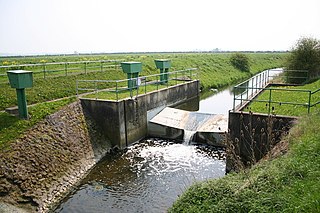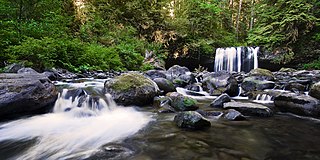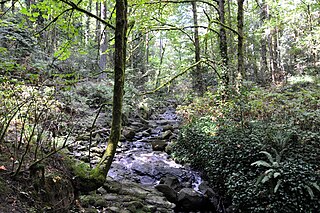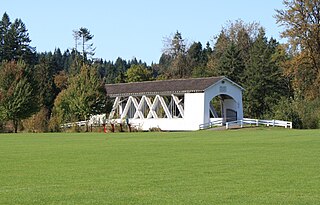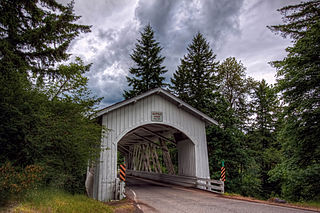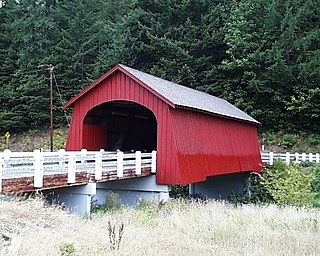| Thomas Creek | |
|---|---|
 Hannah Bridge over Thomas Creek | |
| Etymology | 19th-century settler Frederick Thomas [1] [2] |
| Location | |
| Country | United States |
| State | Oregon |
| County | Linn County |
| Physical characteristics | |
| Source | Willamette National Forest |
| - location | southwest of Detroit Lake |
| - coordinates | 44°39′59″N122°18′54″W / 44.66639°N 122.31500°W [1] |
| - elevation | 3,734 ft (1,138 m) [3] |
| Mouth | South Santiam River |
| - location | west of Scio |
| - coordinates | 44°40′39″N122°58′19″W / 44.67750°N 122.97194°W Coordinates: 44°40′39″N122°58′19″W / 44.67750°N 122.97194°W [1] |
| Length | 35 mi (56 km) [4] |
| Discharge | |
| - location | Scio, Oregon [5] |
| - minimum | 3.4 cu ft/s (0.096 m3/s) |
| - average | 487 cu ft/s (13.8 m3/s) [5] |
| - maximum | 27,400 cu ft/s (780 m3/s) |
| Basin features | |
| Basin size | 117 sq mi (300 km2) [6] |
Thomas Creek is a stream, about 35 miles (56 km) long, in Linn County in the U.S. state of Oregon. Beginning in Willamette National Forest on the western slopes of the Cascade Range, the creek flows generally west through Santiam State Forest and farmland to meet the South Santiam River west of Scio. [7]

Linn County is a county located in the U.S. state of Oregon. As of the 2010 census, the population was 116,672. The county seat is Albany. The county is named in honor of Lewis F. Linn, a U.S. Senator from Missouri who advocated the American settlement of the Oregon Country.

In the United States, a state is a constituent political entity, of which there are currently 50. Bound together in a political union, each state holds governmental jurisdiction over a separate and defined geographic territory and shares its sovereignty with the federal government. Due to this shared sovereignty, Americans are citizens both of the federal republic and of the state in which they reside. State citizenship and residency are flexible, and no government approval is required to move between states, except for persons restricted by certain types of court orders. Four states use the term commonwealth rather than state in their full official names.

Oregon is a state in the Pacific Northwest region on the West Coast of the United States. The Columbia River delineates much of Oregon's northern boundary with Washington, while the Snake River delineates much of its eastern boundary with Idaho. The parallel 42° north delineates the southern boundary with California and Nevada. Oregon is one of only three states of the contiguous United States to have a coastline on the Pacific Ocean.
Contents
Three covered bridges, all listed on the National Register of Historic Places, carry traffic over the creek. Two other covered bridges that originally crossed Thomas Creek were moved to parks in cities outside the creek's watershed. Several covered bridges that once spanned the creek were destroyed in weather-related incidents or were otherwise demolished.

A covered bridge is a timber-truss bridge with a roof, decking, and siding which, in most covered bridges, create an almost complete enclosure. The purpose of the covering is to protect the wooden structural members from the weather. Uncovered wooden bridges typically have a lifespan of only 20 years because of the effects of rain and sun, but a covered bridge could last 100 years.

The National Register of Historic Places (NRHP) is the United States federal government's official list of districts, sites, buildings, structures, and objects deemed worthy of preservation for their historical significance. A property listed in the National Register, or located within a National Register Historic District, may qualify for tax incentives derived from the total value of expenses incurred preserving the property.
The creek at times has flooded Scio, particularly in 1964. The drop in elevation on its upper reaches, coupled with its flow volume, make it suitable at times for whitewater canoes and kayaks. The stream supports populations of smallmouth bass, cutthroat trout, and other fish.
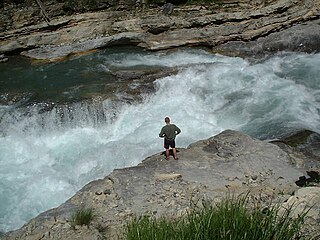
Whitewater is formed in a rapid, when a river's gradient increases enough to generate so much turbulence that air is entrained into the water body, that is, it forms a bubbly or aerated and unstable current; the frothy water appears white. The term is also loosely used to refer to less turbulent, but still agitated, flows.

The smallmouth bass is a species of freshwater fish in the sunfish family (Centrarchidae) of the order Perciformes. It is the type species of its genus. One of the black basses, it is a popular game fish sought by anglers throughout the temperate zones of North America, and has been spread by stocking—as well as illegal introductions—to many cool-water tributaries and lakes in Canada and more so introduced in the United States. The maximum recorded size is approximately 27 inches and 12 pounds. The smallmouth bass is native to the upper and middle Mississippi River basin, the Saint Lawrence River–Great Lakes system, and up into the Hudson Bay basin. Its common names include smallmouth, bronzeback, brown bass, brownie, smallie, bronze bass, and bareback bass.

The cutthroat trout(Oncorhynchus clarkii) is a fish species of the family Salmonidae native to cold-water tributaries of the Pacific Ocean, Rocky Mountains, and Great Basin in North America. As a member of the genus Oncorhynchus, it is one of the Pacific trout, a group that includes the widely distributed rainbow trout. Cutthroat trout are popular gamefish, especially among anglers who enjoy fly fishing. The common name "cutthroat" refers to the distinctive red coloration on the underside of the lower jaw. The specific name clarkii was given to honor explorer William Clark, coleader of the Lewis and Clark Expedition.




